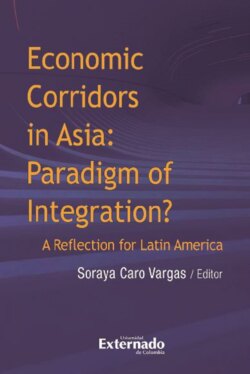Читать книгу Economic corridors in Asia : paradigm of integration? A reflection for Latin America - Varios autores - Страница 31
На сайте Литреса книга снята с продажи.
1. THEORETICAL DISCOURSE ABOUT ECONOMIC CORRIDORS
ОглавлениеThe economic aspects of corridors have been amply covered in the theoretical constructs. Whebell (1969) proposed a corridor-centered economic landscape and stated that it is a useful instrument for urbanization as it creates sustainable methods for populating the space followed by commercial agriculture and thereafter a surge in communication and connectivity, leading to the emergence of metropolitan centers (Whebell, 1969; pages. 1-26). Whebell while applying his argument primarily through metropolitanism, had failed in terms of the development of sub-urban landscapes and the development of satellite townships which form the bed rock of production, services and investment. Kathy Pain, while arguing for the development of corridors, puts cities, corridors and transport into one economic space with each influencing the other (Pain, 2002). There is another argument to the economic corridor which debates it in the context of Development Axes (DA) theory. DA theory proposed by Hilhorst (1972), defined it as connecting and integrating two or more growth poles or centers across continents, trans-national or sub national levels (Hilhorst, 1972). While furthering the Hilhorst argument, Richardson (1978), discussed that this network would facilitate economic agglomeration, bring about price parity and cut down on freight costs and in turn trigger economies of scale of activities (Richardson, 1978, pp. 133-152). It will put the place/node/city along the axes in higher levels of efficiency and will strengthen each endpoint. Stephanie Petrella (2018) proposes an economic space which includes transport corridors, adjoining production centers, and cities. These three economic spaces provide technology, labor, consumption and innovation which is critical to sustain economic growth (Petrella, 2018). Ron Martin (1999) has argued that economic geography plays a critical role for the development of any region be it international, regional or at the local national level because of mathematical economics of imperfect competition, increasing returns to investment and multiple equilibria, leading to agglomeration of economic activity in select regions (Martin, 1999; pp. 387-391). This paper draws from the Ron Martin concept and argues that the development of corridors at the national level does have its utility at sub regional levels also.
Brahmawong (2010), however, raised caution regarding the role of transport and economic corridors and advocated that economic development as a result of economic corridors might help in economic growth and raise national income but would also result in the depletion of natural resources, adverse environmental conditions and diminished livelihood (Banomyong, 2010). While the narratives related to economic corridors do endorse the need for agglomeration of resources and the utility of urban spaces so that economic production and consumption can be facilitated, they argue nevertheless that, economic corridors must be complemented by issues such as labor availability, capital investment and entrepreneurial capabilities so that the development can be comprehensive and reach the larger population.
India has embarked, with this objective in mind, on an ambitious project of development and bringing about the effective utilization of resources. Therefore, various initiatives have been undertaken to integrate production centers through highways and ports while also facilitating transportation so that labor can move without impediments. However, the projects are expected to face challenges which will be discussed later in the chapter. This paper uses empirical data and evaluates it for its efficacy and utility. It further assesses it based on the available documents about the prospects and challenges involved. This paper is based on primary documents and not on field interviews.
